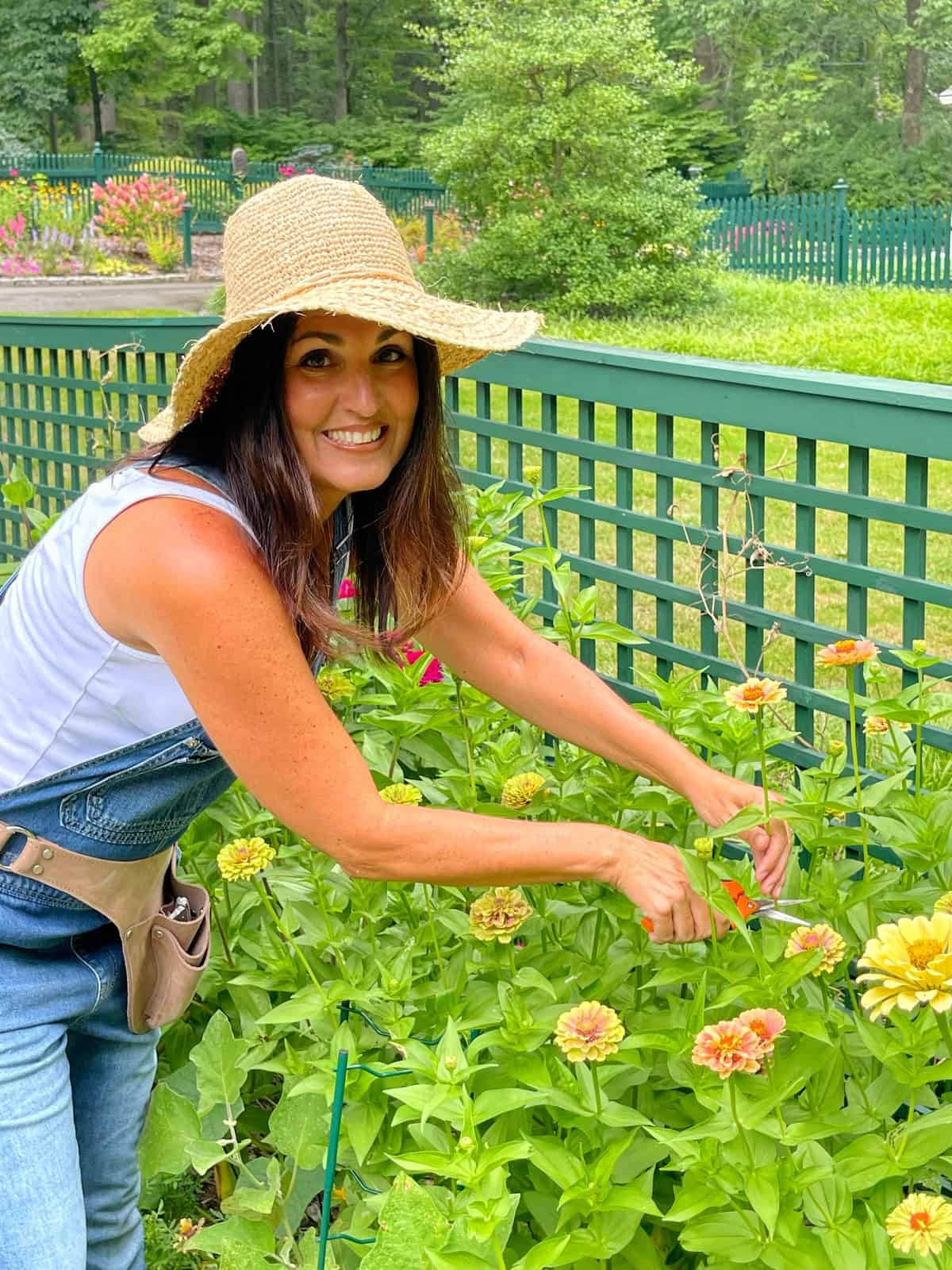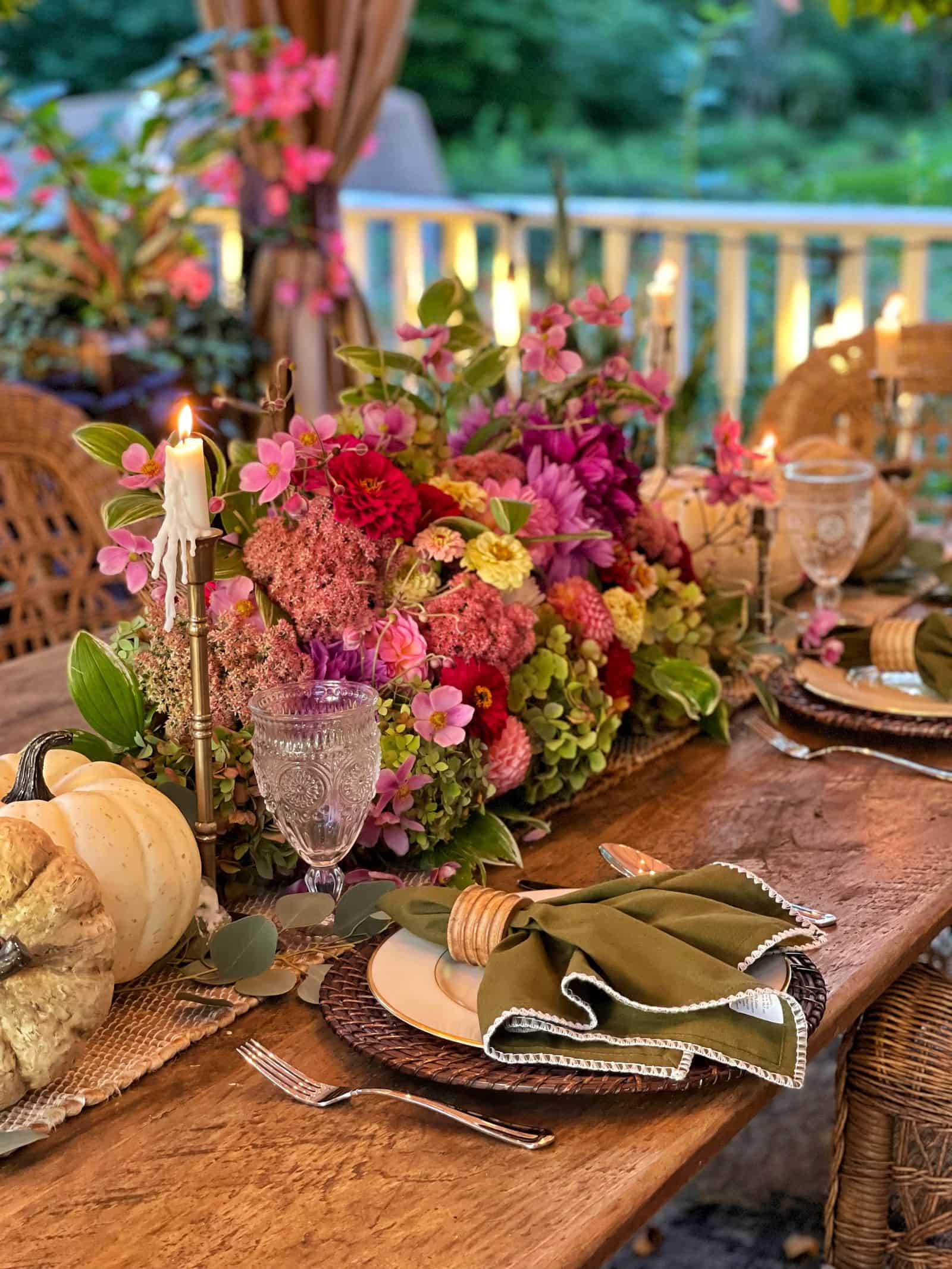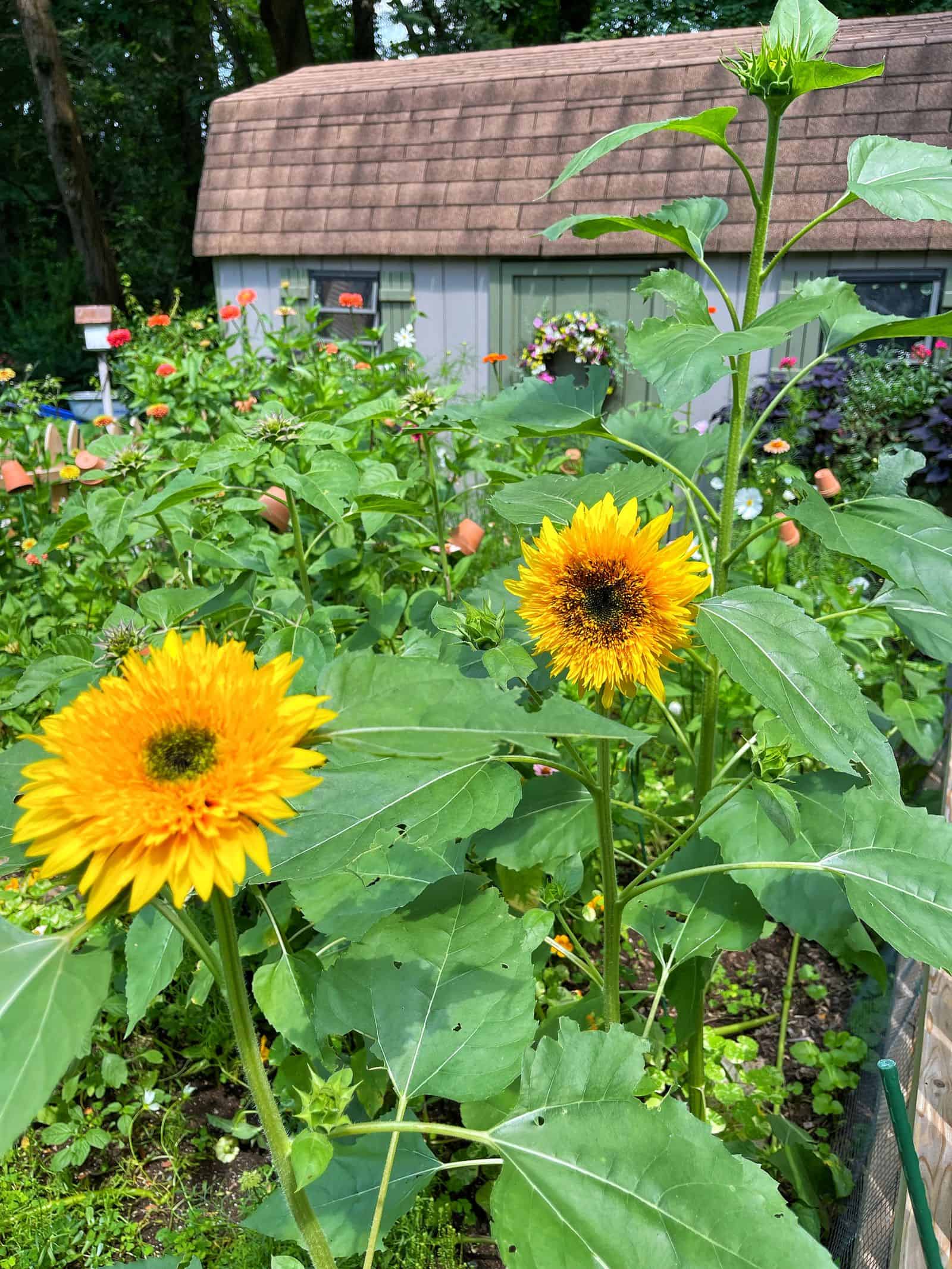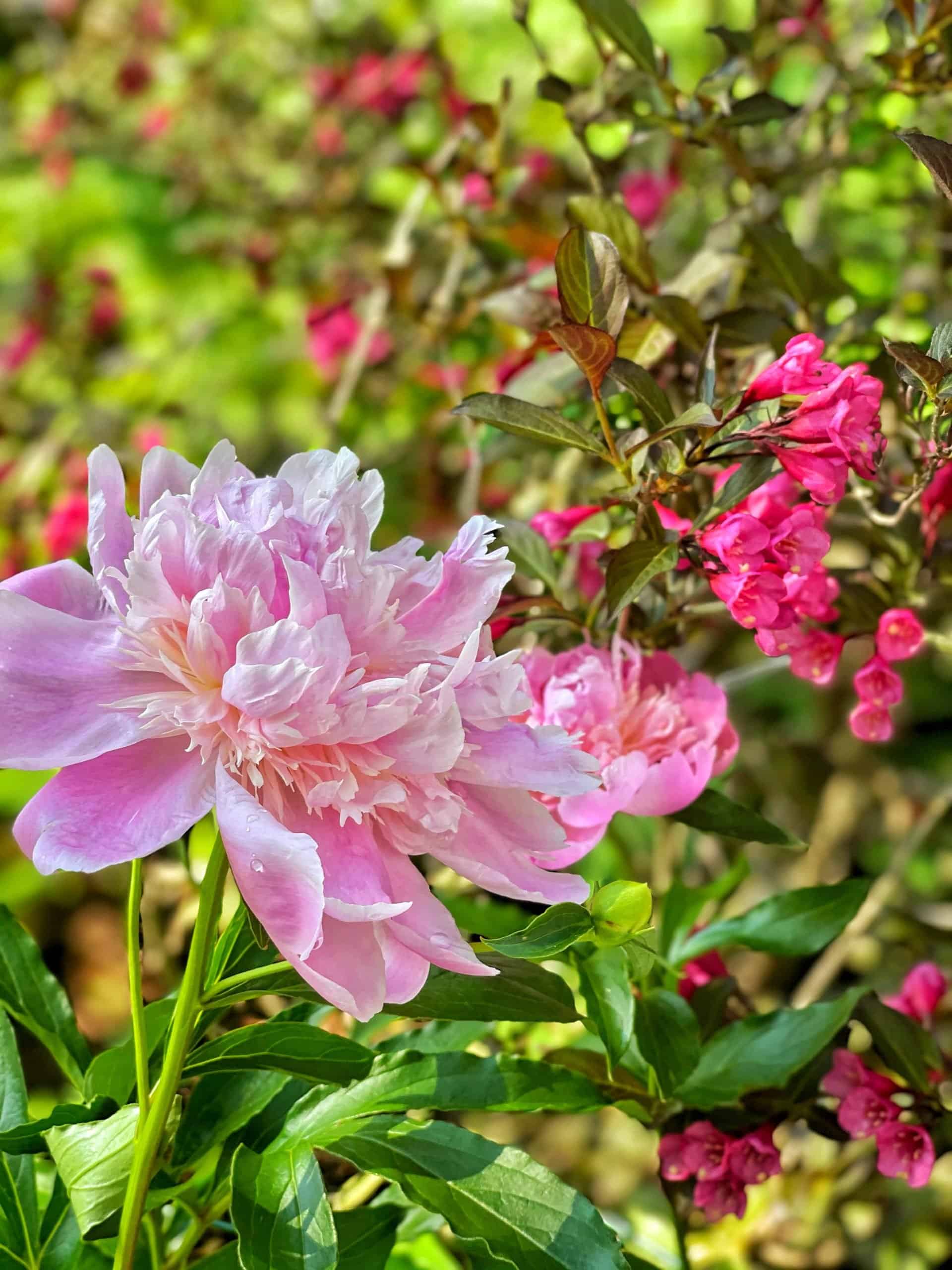Want to grow a beautiful cut flower garden this year? This comprehensive guide will take you step-by-step through the process of growing a cut flower garden from seed to flower to vase.
I’ve been growing flowers since I started gardening over 25 years ago. For me, flowers bring great joy because growing a garden is great therapy for the body and soul. And once the gardening bug bit me. It bit me HARD. My love for gardening and all things flowers started with one garden and grew to well over 13 at my former home.
Over the last several years, I started growing a dedicated cutting garden. Most of the flowers I wanted to grow as cut flowers were not available at the local nursery, so I started them indoors from seed. There are so many cut flower species you can grow. So don’t limit yourself to just what’s available at the nursery. Because starting flowers from seed is SO EASY and you can really grow some fun plants.
Discover the joy of cut flower gardening and transform your home with fresh, vibrant blooms! Keep reading for all my best tips for planning and planting a cut flower garden so you can successfully start your own!
(Posts on stacyling.com may contain affiliate links. Click HERE for full disclosure.)

What Is a Cut Flower Garden?
A cut flower garden is exactly what it sounds like – a garden that specifically grows flowers that are meant to be cut and used in floral arrangements. Cutting gardens typically contain a variety of flowering plants, to produce many blooms that can be harvested without significantly detracting from the overall look of the garden.
When you start a cut flower garden, you can enjoy fresh-cut flowers in bouquets and vases throughout the growing season while also enjoying the beauty of the actual garden on your property.

Benefits of Growing a Cutting Garden: Why It’s Worth Your Time
A cut flower garden is a spot in the landscape where you can grow flowers to cut and make arrangements. Cutting gardens are grown specifically to harvest flowers instead of growing them purely for the aesthetic. Blooms grown are cut and come again flowers. So the more you cut, the more flowers you’ll get.
Throughout most of my gardening life, I hesitated to cut flowers from my gardens because I enjoy watching them grow and change in my landscape. To change that mindset, I started growing a garden with the specific intent of cutting the flowers. And you know what?
IT IS AWESOME!!! I love cutting flowers daily and making garden bouquets. And you will too. Here’s how to do it.

Best Cut Flowers to Grow in Your Garden
There are so many flower options to grow in a cut flower garden, but here are some of my favorites to grow.
- Dahlias
- Zinnias
- Larkspur
- Sweet Peas
- Sunflowers
- Cosmos
- Strawflower
- Delphinium
- Snapdragons
- Hydrangeas
- Calendula
- Tithonia
- Celosia
- Amaranth
There’s so much more, but these are just a few of the best cut flowers that I enjoy growing in my cutting garden.

How Do You Start a Cutting Garden?
The best way to grow a fresh-cut flower garden is to start it with seed. But you can also purchase plants from local garden nurseries. So if you’re not interested in starting cut flowers from seed, you can still purchase flowers that are ready to plant from the nursery.
That said, I recommend starting them from seed if you can because:
- You can grow so many more options and unique cut flower species from seed.
- It’s a rewarding experience to grow plants from seed.
- And it’s a fun indoor gardening activity to do.
Cut Flower Garden Layout: How Much Room Do You Need?
The cut flower garden layout and how much room you need depends on how much room you have and what you want to grow. Research the sizes of flowers you wish to grow and see how much gardening space you have that receives at least 6-8 hours of direct sunlight. Because most flowers grown for cutting need lots of sunshine to grow well.


Can You Grow a Cut Flower Garden in Containers?
Yes, you can grow a cutting garden in pots! If you don’t have a large property or a suitable place to grow cut flowers in the ground, you can try a container garden for your cutting flowers. Many flowers that are popular for cutting, such as zinnias, cosmos, sunflowers, and snapdragons, can thrive in containers as long as they receive adequate sunlight, water, and nutrients.
When growing cut flowers in containers, it’s important to choose pots or containers that are large enough to accommodate the root systems of the plants and provide good drainage. Make sure to also use a high-quality potting mix specifically formulated for container gardening to ensure proper aeration and moisture retention.
Cut flowers grown in containers can also require a bit more maintenance than plants grown in the ground because they can dry out or lose nutrients more quickly. Fertilize your container plants with a balanced fertilizer to promote healthy growth and abundant blooms. I like to use a slow-release fertilizer so it’s set and forget and then hit them with a bloom booster. Be sure to water regularly, too.
With proper care and attention, you can enjoy a beautiful and bountiful supply of cut flowers grown right on your patio, balcony, or doorstep!

Are cut flowers annual or perennial?
Cut flowers can be annuals or perennials, depending on the varieties you choose to grow! Many popular cut flowers are annuals, such as zinnias, sunflowers, cosmos, and marigolds. These plants complete their life cycle within one growing season and need to be replanted the following year.
However, if you are lucky, some flowers drop seed and can regrow the following year. In my garden, that’s happened with celosia, larkspur, and sunflowers.
But there are some beautiful flowers for cutting gardens that are perennials and come back year after year. These include peonies, irises, lilies, asters, lavender, and salvias.

Best Time to Start a Cut Flower Garden
Most cut flower gardens are started in spring, but the exact month that is best to start yours depends on your location and climate. In many climates, you can start preparing the soil and start seeds indoors in late winter to early spring, typically around March or April. You’ll also typically want to avoid planting any seedlings outdoors until the last frost date has passed for your area.
That said, you could get started even sooner than spring using the winter sowing method. It’s one of the easiest ways to start certain flowers from seed and I highly recommend giving it a go if you are up for it. You can learn more about winter sowing seeds here.
No matter where you live, it’s a good idea to research the specific growing requirements and planting times for the flowers you’re using in your garden. Every variety is different and some can be planted earlier than others.
What month is too late to start a garden?
There’s not a specific month that’s too late to start a garden entirely. After all, some flowers bloom in late summer to early fall. But in most cases, you’ll want to get seedlings planted in your cut flower garden before the high heat of summer sets in to ensure they’re able to get established in the ground (or containers) without drying up.

Step-by-Step Guide to Growing Your First Cut Flower Garden
Choosing the Perfect Sunny Location for Cut Flowers
Before beginning, find a spot in your yard that receives at least 6-8 hours of direct sunlight. Because a vast majority of cut flowers require full sunlight. If you aren’t sure where that is, study different areas of your yard throughout the day to find the best spot.
And if it’s too cold to physically make the garden (like you are in the middle of winter), create a cut flower garden layout by planning the size and shape so you know how many types of cut flowers to order.

Ordering Seeds For Your Cutting Garden
When starting a cut flower garden, it’s important to purchase high-quality seeds. While some sources sell year-round, you’ll see the best supply in December and January. My go-to sources for high-quality seeds are Floret Flower Farm and Johnny’s Select Seeds. Before ordering seeds, think about how you want your cutting garden to look. Consider the colors, bloom time, and heights so you can plan where everything is going.
Easiest Cutting Flowers to Start From Seed
As with plants, there are some flowers that start easier from seed than others. If you are just starting out with growing a cut flower garden, start with these cutting flowers.
- Zinnias
- Sunflowers
- Snapdragons
- Calendula
- Tithonia
- Nasturtium
- Borage
- Cosmo
- Strawflower
- Celosia
By no means is this an exhaustive list. But rather these are cutting flowers that I think are super easy to grow for beginners.

3 Ways to Start Seeds for Your Cutting Garden
So you’ve got your garden planned out, you ordered seeds, now what? Regardless of the method you use, sowing seeds will be the same depending on the flower varieties you choose to grow. Read the seed packet directions to determine when and how to start sowing them.
Know when your last frost date is because that date will drive when to start sowing seeds. Some seeds, like larkspur, will have a chill requirement before sowing. Others like sweet peas, need to be pre-soaked and sowed 10-12 weeks prior to the last frost date.
If you’ve never sowed seeds before, it is very simple to do. I shared the process here (and it’s super easy). But there are a few ways to so sow seeds.

Starting Seeds Indoors
Starting a cut flower garden doesn’t have to wait for warm weather. If you’re eager to get a head start on the growing season, starting seeds indoors is a fantastic option. Not only does it give you a wider selection of flower varieties than those available as transplants, but it also allows you to control the growing conditions and ensure healthy, robust seedlings. To learn more about how to start seed indoors, read this article.

Directly Sowing Seeds Outdoors
If you’re looking for a low-maintenance way to add color and life to your garden without the hassle of indoor seed starting, consider direct sowing flower seeds! It’s much less expensive than purchasing mature plants and a great way to get your flower garden game going.
When the last frost date arrives, direct sow seeds that you didn’t start indoors. I prefer starting some seeds this way, such as sunflowers and nasturtiums. Directly sow flowers in the garden according to packet directions. If seeds require sowing before the last frost date, follow that.
If you are direct sowing, consider succession planting where you sow seeds a few days to a week apart to get an extended bloom time from flowers that are typically one-and-done, such as sunflowers. Read more in this post about the easiest flowers to directly sow in your cutting garden.
Winter Sowing Techniques for Outdoor Seed Starting
As an alternative to starting seeds indoors, you cut down on using all those indoor seed-starting supplies by sowing seeds outdoors in winter. It works best with cool-season annual flowers like sweet peas, snapdragons, foxgloves, larkspur, calendula and more. Read more about how to winter sow seeds in recycled containers in this post.

Preparing Your Cut Flower Garden
When the ground can be worked in early spring, it’s time to start your new cutting garden. If you plan to grow your new cut flower garden in the ground, be sure to remove all of the existing grass and make clean edges around the bed so grass roots don’t grow back into the new garden. To follow a step-by-step tutorial, learn how to start a new garden here.
Did you know there’s an easier way to start a garden in the ground without breaking your back?
Yes! It’s called lasagna gardening and you’ll need to plan ahead to do it though because it requires laying down a barrier that will break down over time. For a cutting garden, I recommend doing this at least 6 months to a year ahead of time.

Can I Use Weed Fabric in a Cut Flower Garden?
I’ve been asked about using weed fabric as that barrier in flower beds and I do not recommend it unless you plan to remove it before planting the bed. To me, it’s much easier to use cardboard or newspaper that will break down over time and enrich the soil.
I use weed fabric in very limited situations. Such as this raised bed garden for vegetables. Since I used the fabric as a barrier beneath the raised bed and applied pea gravel on top, I won’t ever need to dig in it, nor will I want my plants to self-sow there.

How to Harden Off Seedlings: Preparing for Life Outdoors
If you started seeds indoors, the hardening-off process is when plants are transitioned from growing indoors or in a greenhouse environment to the outdoor elements of fluctuating weather to help prevent shock from environmental changes.
It’s a two-week process that involves acclimating tender seedlings to outdoor living. While it sounds like a lot it’s very easy to do. And it is something that you can’t skimp on either. I shared an easy guide to hardening off seedlings in this post.

Planting Your First Cutting Garden: A Beginner’s Guide
When plants are hardened off, it’s time to plant your cut flower garden. Be sure to plant smaller varieties in the front and taller varieties toward the back. If you pre-planned your garden design, plant according to your garden layout. And if you are following a general design but sort of winging it?
Consider the color combinations of flowers you are growing and group plants together that are aesthetically pleasing.
Finally, protect young seedlings from harsh weather conditions such as extreme heat and wind until they acclimate after planting. When I grew my cut flower garden a few years ago, New Jersey experienced extreme heat for about a week, so I kept my flowers well-watered so they would not dry out.

Essential Tips for Maintaining a Thriving Cutting Garden
Growing a cut flower garden for beginners doesn’t stop when you get the plants in the ground. Learning how to care for and maintain your garden properly is an important next step.
Staking and Supporting Tall, Heavy Flower Varieties
When planting, it’s important to know which plants will require support as they grow and mature. Cut flowers requiring more support will generally be taller varieties, typically over two feet tall, and have heavier flower heads.
Typical plants that need additional support are dahlias, zinnias, snapdragons, delphiniums, peonies, cosmos, and several others. Of course, it depends on the cut flower species, so make sure you read the seed packets or plant tags for direction from the grower because they usually offer great guidance.

Why We Need to Stake Plants
It is necessary to provide additional support for taller and more substantial flowers from heavy rain, strong winds, and the weight of blooms. Because without that extra support?
They will topple over. And we don’t want that! There are a few ways to stake or support cut flowers including:
- Grow Through Supports
- Corralling
- Netting
- Staking
- Trellising
- Obelisk
- Fencing

When is the Best Time to Support Cut Flowers?
Now that we know we need to support taller and more sizeable flowers, when do we stake plants?
Because growth happens quickly, it’s best to start whatever support system you choose either when you plant or before the plants reach about a foot tall. I suggest staking when you plant because growth happens fast in spring and if you aren’t paying attention, it can be tough to support plants later.
And trust me when I tell you, I tend to put off staking thinking I have plenty of time and that’s a huge mistake. Because growth sneaks up on you in spring! So I am trying to be better with it and setting up my support systems early when in the growing season or when I plant seedlings. I know it won’t look great until the plants mature, but because I know how I garden, I need to start this process early!
Therefore, my best advice is to consider doing it when you plant versus waiting until it’s about a foot tall.

Best Practices for Fertilizing Cutting Garden Flowers
Fertilizing is necessary to provide the nutrients needed to grow healthy and bloom. When seedlings are planted in the ground, fertilize with a fish emulsion fertilizer for the first week or two. After plants acclimate, which is usually around a week or two, add a slow-release fertilizer like this.
As an aside, I feed both my annuals and houseplants with this same slow-release fertilizer too. It lasts about four months. And in New Jersey, that’s pretty much the growing season. So for me, the slow release fertilizer is a set-and-forget approach to feeding my cut flower garden.

Watering Techniques for a Thriving Cut Flower Garden
Of course, watering cut flowers is one of the most important things you can do to grow a flourishing garden. It’s important to understand the unique watering needs of the types of plants in your garden, but in general I like to follow these watering guidelines:
- Water deeply and infrequently: Instead of watering a little bit each day, water your cut flower garden deeply but less often. This encourages deeper root growth and helps plants become more resilient to drought. Use a soil moisture meter or dig down a few inches with your finger to check the soil’s moisture before watering.
- Water in the morning: This allows plants to absorb moisture before the heat of the day. Avoid watering your plants at night because moisture stays on the foliage longer and promotes fungal growth.
- Water the base of plants and consider drip irrigation: Drip irrigation hoses deliver water directly to the base of plants, resulting in less water loss through evaporation and reducing the risk of fungal disease on plants’ foliage. You can install drip irrigation lines throughout a cutting garden near the roots of the plants.
- Adjust watering based on the weather. It’s great to get in a good watering routine but don’t forget to pay attention to the weather! Your flowers may need more water during hot, dry periods. On the other hand, if your area is getting a lot of rain, you probably don’t need to water quite as often.

Deadheading 101: Keeping Your Cut Flowers Blooming
Deadheading cutting flowers is generally recommended to prolong the blooming period and encourage the production of new flowers. This process involves removing spent flowers from the plant. This helps redirect energy from seed production back into growth and flowering.
To deadhead cutting flowers, simply pinch or snip off the faded flowers at the base of the stem, just above a set of healthy leaves or buds. Use clean, sharp pruners or scissors to avoid damaging the plant.
Deadheading should be done regularly throughout the growing season, as needed, to keep your cut flower garden looking its best and producing consistent blooms.

Attracting Pollinators: Essentials for a Lively Cut Flower Garden
One of the best things you can do for the health of your cut flower garden is to plant flowers that naturally attract pollinators like bees and butterflies. There are plenty of flowers that attract pollinators, but you can also include flowering herbs to support the process such as lavender, dill, or salvia. Having these pollinators in your garden will help increase flower yields and improve the overall health of your garden.
Protecting Your Cutting Garden from Pests and Diseases
Protecting a cut flower garden from pests is essential for maintaining healthy plants and maximizing flower production. It can also be one of the most challenging parts of growing a cutting garden! Here are a few of my favorite tips for keeping pests away from your flowers:
- Choose resistant varieties: Research flowers that are less susceptible to pests in your area and choose those for your garden. There are many types of deer-resistant flowers, for example, that can help keep deer away naturally.
- Companion Planting: Include plants that help deter pests or act as a trap plant. Some great options include calendula, borage, nasturtiums, and marigolds.
- Actively monitor pests: Inspect your garden regularly and keep an eye out for pest activity, such as chewed leaves, holes or insect eggs. You can prune and remove any heavily infested plants to avoid spreading or try out a non-toxic pest control spray.
- Try natural pest control methods: There are so many options to get rid of pests and weeds in the garden today that don’t have to involve harsh chemicals. Try a natural pest control method such as neem oil, diatomaceous earth or homemade pest sprays.

Cut Flower Gardening: Essential Winter Preparation Tips
If you want your spring gardening to be more enjoyable, then it’s important to prepare your cut flower garden for winter. Properly winterizing your garden can help protect perennial plants and maintain soil health.
You can start by cleaning up garden beds in late fall, making sure to remove any debris or dead plant material. This can help prevent the buildup of pests and disease over the cool, wet winter months.
I also recommend adding a layer of much to your beds once they’re cleaned up to help insulate the soil and protect plant roots from freezing temperatures. I especially like to do this with leaf mold compost, shredded leaves picked up in the fall. This can also help insulate and protect any perennials that are in your garden.
By taking the time to prepare a cut flower garden for winter, you can set the stage for a successful growing season come spring!

Top 7 Lessons Learned Growing a Cutting Garden
As with all things, we all make mistakes, right? From cutting corners to learning as you go, cut flower gardening is a learning experience. Here are 7 mistakes I made growing a cutting garden.
- Not taking good notes in a garden journal
- Trying to grow every seed in the seed packet instead of saving them for later
- Not planning a cut flower garden layout
- Supporting flowers too late
- Not using the best garden supports for taller, heavier flowers
- Not following the seed packet directions
- Getting lazy and not labeling EVERYTHING
Learn more about the lessons learned best ways to address each of these mistakes so you don’t experience the same gardening fails I did when growing a cut flower garden.

Harvesting Flowers for Bouquets
Best Time to Cut Fresh Flowers
The ideal time to cut fresh flowers is in the early morning because evenings are cool and they have some morning dew. That said, it’s okay to cut flowers in the evening as well. Just avoid the heat of the day because they won’t last as long in arrangements.
Select flowers that recently opened, closely looking at the petals and foliage. Choose ones that have some buds because they’ll extend the bloom time in your arrangements.
- Bring a bucket of warm water with you to the garden.
- Avoid using cold or hot water.
- Using clean sharp pruners or snips, cut flowers slightly above a side branch or where you see another flower branch forming.
- Cut the foliage off of the stems as you work so they don’t sit in the water.
- Then plunge the cut flowers directly into the bucket of water.
It’s best to let them sit in the warm water for a few hours in a cool shaded location to acclimate them to life in an arrangement before making garden bouquets.

How to Cut Flowers From Your Garden
Want your cut flowers to last a long time in arrangements? Follow these easy tips!
- Timing: The ideal time to cut flowers is in the early morning or late evening when temperatures are cooler. This helps the flowers retain moisture and reduces stress on the plants
- Tools: Use clean, sharp scissors or pruning shears to make a clean cut. This prevents damage to the stems and helps with water uptake.
- Technique: Cut the stems at an angle just above a set of leaves or a node. This encourages the plant to produce more flowers and helps the stem absorb water more efficiently. Try to cut deep into the plant to get a long stem and to open it up for better air circulation. This will keep your plants healthier during the growing season.
- Hydration: Place the cut flowers in a bucket of water immediately after cutting. This ensures they stay hydrated and fresh.
- Post-Cutting Care: Remove any leaves that will be submerged in water to prevent rot. Use a floral preservative in the vase water to extend the life of the flowers. If you don’t have a preservative, you can follow this DIY flower food recipe or usingclean water is the next best option.
DIY Floral Arrangements: Using Blooms from Your Cutting Garden
So now you’ve grown a beautiful cut flower patch and you want to make garden bouquets that you can decorate inside your home or give away to friends and family. Here is what you need to know to arrange flowers and enjoy cut flowers from your garden!
- Once fresh-cut flowers acclimate (usually after about 2-3 hours), it’s time to make the arrangement.
- Choose a container like a vase, bowl, etc.
- Strip off any leaves that sit lower than the waterline.
- Be sure to remove any leaves that will sit below the waterline because they will decompose and contaminate the water which will lessen the life of the arrangement. And if you are going to do all this work, you want these flower bouquets to last!
- You can use a floral frog, floral tape or even scotch tape to help keep the flowers sturdy in the arrangement. If using tape create a grid pattern, then drop your flowers in.
- Re-cut stems on a slant so the flowers can take in freshwater better. The general rule of thumb is to cut flowers roughly 1.5 – 2x the height of the container you are using.



Preserving the Beauty: How to Keep Cut Flowers Fresh Longer
Now that we’ve grown and made a gorgeous flower arrangement, how do we keep fresh cut flowers longer? Follow these simple tips to prolong the life of your fresh cut flower arrangements.
- Always start with a clean vase or floral foam
- Prepare each flower for the arrangement
- Feed fresh-cut flowers to prolong their vase life
- Keep the water clean
- Re-cut stems when you change the water
- Keep fresh flowers out of direct sunlight
- Remove wilted blooms and petals

Expert Advice for Aspiring Cut Flower Gardeners: Getting Started Right
If you are just starting out with cut flower gardening, my best advice is to start small, get your feet wet, and build some confidence. Our eyes are always bigger than our stomachs when it comes to growing plants and flowers, but trust me when I tell you, the larger the garden the more work it is.
And if you are a beginner gardener or new to cut flower gardening, starting with a smaller garden will help manage the beds better, grow plants with more confidence, and enjoy the experience more.
You’ll look back on the experience feeling like it was rewarding and likely wanting to do more instead of collapsing on the sofa frustrated that it was too much work. Because growing a cut flower garden is a rewarding experience that you’ll enjoy for years to come.
Thanks so much for growing stuff with me! I hope you found these tips on cut flower gardening for beginners helpful and are inspired to grow one this year!
See you in the garden.
For more information about growing a cut flower garden, see these cooperative extension articles:
- North Carolina Cooperative Extension
- The Missouri Cooperative Extension
- University of California Cooperative Extension
Thank you for visiting the blog today!
Enjoy your day! xo




























